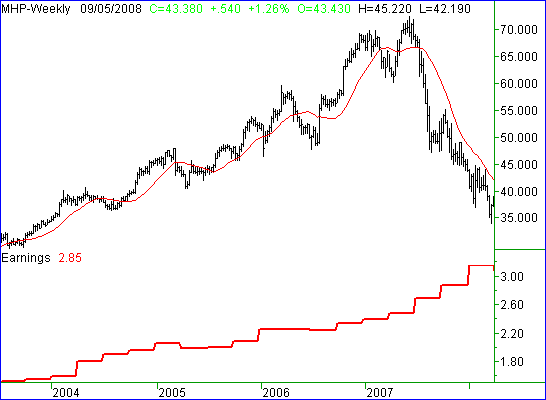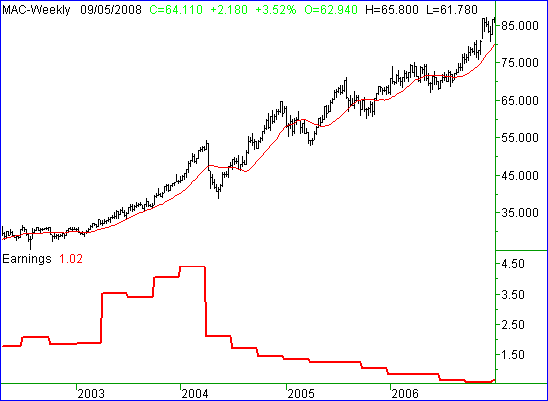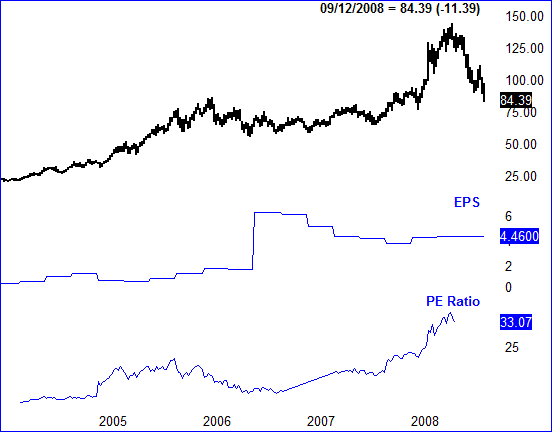|
Fundamental Values Mean Little Right Now
Last few weeks have been a great reminder of a lesson too easily forgotten. That lesson is stocks don't always trade at what they're worth.
There's a sub-lesson built in there too. The market doesn't even know what a stock should be worth much of the time.
The principle is even true for the market and economy as a whole. Remember a couple of weeks ago when the second quarter's GDP was revised significantly higher? The market loved it, and stocks rallied. Then unemployment spiked; the market hated that. Fannie and Freddie were bailed out, which the market loved for a few hours. Then the Lehman bomb was dropped, giving us Tuesday's demise.
My point is, unless you can travel into the future and the then travel back again, frankly, nobody really knows enough to determine the market's actual value. We can make assumptions (even pretty good ones) about what it's probably worth -- playing the odds, so to speak. However, clearly all those buyers who poured into stocks following the GDP revision were wrong about what that meant.
Or, if they were right, it didn't matter. Stocks got whacked either way.
In other words, if the market is going to respond to every shred of economic news, and if that news is mixed (as it has been lately), how can one expect any kind of trend to develop? Yet, traders are assuming -- every step of the way -- that each piece of economic news is the last and final piece of economic news. They're assuming that there's no other news coming out later, and that hour's trend is going to last indefinitely.
I'm not saying I have a crystal ball either, but I do have a good tool (charts) to help me figure out if there's an actual trend developing. That's why I haven't been all that interested in a whole lot of new trades lately. No move has lasted more than a few hours. The news didn't tell me that; charts told me that.
None of this is really a shocking revelation. It's just become very clear again within the last few days that this business of trading the market isn't an exact science, nor is it about figuring out the "value." It's an odds game of buying low and selling high, even for long-term investors. If you mis-assess the odds, well, you know what can happen.
Lesson #1: Stocks don't always trade at what they're worth.
That's a huge danger to an investor strictly focused on fundamentals. Let's use McGraw Hill (MHP) as an example. The chart below plots McGraw Hill shares on top, and trailing twelve-month earnings on the bottom.
McGraw Hill (MHP) with TTM earnings (weekly)

As you'll see, earnings were on the rise between 2003 and 2008 (quite nicely in fact). The stock was also rising during this time...until early 2007. By the fall of 2007, MHP was shares were starting to fall apart, sinking from $69 in June of last year to a low around $34 by March of this year. Yet, earnings were on the rise the entire time.
Would an investor looking for earnings increases be justified in buying MHP? Yep. Would that investor have lost money? Yep. Just for the record, yes, eventually McGraw started to recover. It was a year later though - a year of lost time, and digging yourself into a big hole.
Another example is Macerich (MAC). Between the middle of 2004 and December of 2006, we saw Macerich shares rally from $41 to $85. Surely a massive gain (more than a doubler) could only reflect wildly strong and ever-improving earnings, right? Wrong. Earnings were falling the entire time.
Macerich (MAC) with TTM earnings (weekly)

Should a fundamental investor have steered clear of Macerich? Yes. Would they have made money even if they had invested in Macerich anyway? Yes, a lot of it.
In both cases, you could make the argument that stocks were trading on a forward-looking basis, or what the market thought they'd be worth by twelve-months later. I agree that stocks are largely priced projectively. However, in both of these cases, the earning's trends as well as the stock's trends persisted for well after any new forecast could have been incorporated into the price. In other words, no, the market knew about - but didn't respond to - a possible change in the earnings forecast.
Bottom line isstocks don't always trade as what they're worth.
Lesson #2: The idea of "worth" is strictly an opinion, and an ever-changing one at that.
It's hard enough to hit a target; it's even harder when it's a moving target. Even if you understand and can adapt to lesson #1, lesson #2 still makes it tough to even make an assessment of value, even if you're willing too.
Unfortunately I can't plot a chart of what investors were thinking at any point in time - that's not quantifiable. However, I will point out something for EOG Resources (EOG), using a chart.
EOG Resources (EOG) with EPS and P/E (weekly)

-- In 2004 while earnings were rising, the P/E was still only about 8.3.
-- In 2005 earnings were declining, yet the stock was priced higher than 2004...and the P/E was around 17.
-- In 2006, earnings were growing again (to record levels), yet the P/E fell to 11.
-- In 2007 and 2008, earnings basically were flat, yet the P/E moved from 14 to 33.
So basically, EOG was "too expensive" when earnings were rising and the P/E was 8.3, but EOG was a "bargain" with a P/E anywhere between 14 and 33, even though earnings were flat during that time?
The question is, what's a fair price for EOG? That's the point - the "fair" price is always changing. Again, I understand that stocks trade based on likely future values. What we're seeing here, however, is that the market either overestimated or underestimated EOG's future earnings.
Bottom Line
I bring this up today because I know what's going on out there right now. Some stocks are in the rise for no apparent reason, while undervalued stocks are still getting trashed. That's the message -- just because stocks "should" trade at what they're worth (whoever defines that worth) doesn't mean they will or do trade that way. The charts are far more important than the fundamentals in the current environment. In fact, looking at fundamentals alone right (good or bad) now could be disastrous.
Price Headley is the founder and chief analyst of BigTrends.com.
|